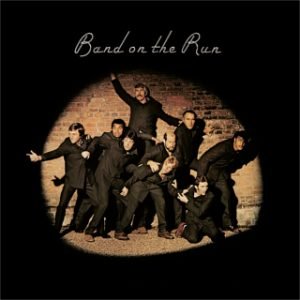Released in December 1973, Band on the Run stands as a pivotal moment in Paul McCartney’s post-Beatles career, both solidifying his identity as a solo artist and pushing the creative boundaries of his band, Wings. The album marked a turning point, not just for McCartney but for the broader rock landscape of the 1970s.
Following the dissolution of The Beatles, McCartney’s early solo work received mixed reactions, with albums like McCartney (1970) and Ram (1971) showing glimpses of his genius but failing to capture the widespread acclaim he once enjoyed. With Band on the Run, McCartney not only sought to reclaim his position as a leading figure in popular music but also to craft a cohesive artistic statement that reflected both personal and professional liberation.
Artistic Intentions
In the context of Wings’ discography, Band on the Run is a significant departure from their earlier efforts, which often leaned towards more whimsical, sometimes fragmented compositions. Albums like Wild Life (1971) and Red Rose Speedway (1973) exhibited McCartney’s tendency to experiment with genre and structure, yet lacked the focus and depth that characterized his work with The Beatles. With Band on the Run, McCartney channeled these eclectic impulses into a more refined and ambitious project. The album’s production, songwriting, and thematic unity suggest a conscious effort to create something enduring and expansive, reflecting a matured artistic vision.
At its core, Band on the Run is an exploration of freedom and escape, themes that are both personal and universal. McCartney, who faced significant legal and personal challenges in the years following The Beatles’ breakup, seemed to use the album as a vehicle to process these experiences. The title track, with its shifting narratives and dynamic structure, encapsulates the desire to break free from confinement, whether literal or metaphorical.
Through this album, McCartney aimed to transcend the expectations that had been placed on him as a former Beatle, demonstrating his capacity to evolve and remain relevant in an ever-changing musical landscape. By integrating rock, pop, and elements of progressive music, McCartney and Wings crafted an album that resonated with the spirit of the time, while also offering a timeless exploration of autonomy and artistic freedom.
Sonic Exploration

Band on the Run is a masterclass in sonic craftsmanship, showcasing Paul McCartney’s ability to blend high production values with inventive musical arrangements. Recorded under unique and challenging circumstances—much of it at EMI’s studio in Lagos, Nigeria, with a limited band lineup—the album’s production nonetheless emerged as polished and dynamic, a testament to McCartney’s resourcefulness and vision. The clarity of the recording, especially given the rudimentary equipment available in Lagos, is remarkable. Each instrument is meticulously placed within the mix, creating a sound that is both rich and spacious, allowing the various textures to breathe and interact in engaging ways.
The production quality on Band on the Run is decidedly crisp, with a warm, analog feel that captures the essence of the early 1970s rock sound. Yet, there’s a certain rawness, perhaps a reflection of the album’s backstory—after all, the decision to record in Nigeria was as much an adventure as it was a retreat from the familiar. This balance between polish and grit enhances the album’s thematic focus on liberation and escape, giving the music an edge that complements its lyrical content. The lush string arrangements, particularly on tracks like “Jeten” and “No Words,” contrast with the driving rock instrumentation, creating a dynamic interplay between sophistication and spontaneity.
Musical Arrangements
Musically, Band on the Run is a tour de force of arrangements. McCartney, ever the studio wizard, layers multiple guitars, keyboards, and vocal harmonies to create a soundscape that is both complex and accessible. The album’s opener and title track is a prime example of this, with its three-part structure that shifts seamlessly from a brooding acoustic introduction to an anthemic rock section, and finally to an exuberant conclusion. This song alone encapsulates McCartney’s genius for arrangement, as he effortlessly combines different musical ideas into a cohesive narrative journey.
Genre Elements
Throughout the album, McCartney explores a variety of genres, blending them in ways that feel organic and innovative. Rock remains the album’s foundation, but elements of pop, folk, and even a touch of progressive rock are woven into the fabric of the songs. For instance, “Bluebird” flirts with jazz-inflected melodies, its gentle acoustic strumming and airy vocal harmonies evoking a breezy, almost tropical atmosphere. Meanwhile, “Let Me Roll It” channels a bluesy rock groove, with its heavy riff and echo-laden vocals nodding to the raw power of classic rock while still feeling distinctly McCartney.
Perhaps most striking is McCartney’s ability to traverse these genres without losing the album’s overarching coherence. The songs on Band on the Run are diverse, yet they all contribute to a unified sonic vision. The album doesn’t just dabble in different styles; it synthesizes them, creating a sound that is at once familiar and fresh. This genre-blending approach allows McCartney and Wings to transcend the limitations of any single category, crafting a work that is both a product of its time and a timeless exploration of musical possibilities.
Lyrical Analysis

The lyrics of Band on the Run are a crucial component of its artistic impact, weaving together themes of freedom, escape, and resilience with McCartney’s characteristic wit and melodic sensibility. At the heart of the album lies a narrative of liberation—a desire to break free from both literal and metaphorical constraints. This is most evident in the title track, “Band on the Run,” which tells the story of a group of prisoners escaping from their captors.
The lyrics—“If I ever get out of here, thought of giving it all away / To a registered charity, all I need is a pint a day”—capture the yearning for freedom while subtly critiquing the pressures and expectations that can trap individuals in unwanted situations. The song’s triumphant chorus, “Band on the run,” echoes the joy and relief of breaking free, embodying the album’s overarching theme.
Recurring motifs of escape and renewal are threaded throughout the album. In “Jet,” McCartney uses the story of a young man’s rebellious departure from home as a metaphor for asserting one’s independence. The song’s cryptic lyrics—“Jet! I can almost remember their funny faces / That time you told them that you were gonna be marrying soon”—blend personal memory with a broader sense of youthful defiance.
Similarly, “Bluebird” offers a softer take on the theme of freedom, with its imagery of flight and open skies symbolizing love as a liberating force. The refrain, “Touch your lips with a magic kiss, and you’ll be a bluebird too,” suggests that emotional connection can transcend physical boundaries, reinforcing the album’s focus on breaking free from limitations.
Lyrical Depth
Lyrically, Band on the Run strikes a balance between straightforward storytelling and more abstract, poetic expression. McCartney’s lyrics are often narrative-driven, yet they possess a depth that invites multiple interpretations. For example, “Mamunia” can be seen as a simple ode to gratitude and resilience—“Mamunia, Mamunia, Mamunia / Oh, oh, the rain is over and gone”—but it also resonates on a symbolic level, suggesting the idea of finding solace and renewal even in adverse circumstances.
McCartney’s gift for wordplay and imagery shines through in songs like “Picasso’s Last Words (Drink to Me),” where he reflects on the fleeting nature of life and art. The lyrics, inspired by a conversation with actor Dustin Hoffman about Pablo Picasso’s final days, blend whimsy with introspection, as McCartney muses on mortality and legacy in a way that is both lighthearted and poignant.
Emotional Impact
The emotional impact of the lyrics in Band on the Run is undeniable. McCartney’s words, coupled with his emotive vocal delivery, evoke a wide range of feelings—from the exuberant joy of escape in the title track to the introspective melancholy of “No Words.” The album’s lyrics have a way of resonating on both a personal and universal level, inviting listeners to project their own experiences onto the stories McCartney tells.
Songs like “1985,” with its anthemic closing refrain, capture a sense of urgency and determination, while the reflective tone of “Let Me Roll It” conveys longing and vulnerability. The emotional depth of the album lies in its ability to explore complex themes through lyrics that are at once accessible and rich in meaning, leaving a lasting impression on listeners and ensuring the album’s place as one of McCartney’s most enduring works.
Cohesion and Flow

Band on the Run is not just a collection of songs; it’s a meticulously crafted journey that flows with an impressive sense of purpose and unity. From the opening chords of the title track to the climactic finale of “Nineteen Hundred and Eighty-Five,” the album demonstrates a carefully considered progression that feels both organic and intentional. McCartney expertly arranges the tracks to create a narrative and emotional arc, taking the listener on a ride through the highs and lows of escape, introspection, and ultimately, triumph.
Track Progression
The album opens with “Band on the Run,” a mini-epic that sets the tone for what’s to come. Its shifting tempos and moods not only introduce the central theme of liberation but also foreshadow the album’s dynamic range. As the song seamlessly transitions from its somber beginnings to an energetic conclusion, it establishes a template for the rest of the album—songs that evolve and surprise while maintaining a cohesive narrative thread.
The progression from “Band on the Run” to the following tracks is smooth and logical. “Jet” picks up on the exuberance of the title track’s conclusion, offering a punchy, upbeat follow-up that sustains the momentum. Yet, the album isn’t afraid to shift gears, as seen in the transition to “Bluebird,” a gentle, melodic ballad that introduces a moment of calm and reflection. This careful pacing ensures that the album remains engaging, with each track offering something new while still fitting into the overall story.
McCartney’s skillful sequencing is further evident in the way he balances different moods and tempos. The mid-album sequence, with tracks like “Mrs. Vandebilt” and “Let Me Roll It,” blends lighthearted, whimsical elements with deeper, more introspective moments. “Mrs. Vandebilt” adds a touch of humor and levity, with its catchy “Ho, hey ho” chant and playful lyrics, providing a contrast to the bluesy, raw emotion of “Let Me Roll It.” This ebb and flow of energy keeps the listener invested, preventing the album from feeling monotonous or disjointed.
Thematic Consistency
Thematic consistency is one of Band on the Run’s greatest strengths. Despite the diversity of genres and styles—ranging from rock and pop to folk and blues—the album maintains a coherent thematic and emotional identity. The recurring motifs of freedom, escape, and renewal are woven through both the lyrics and the music, creating a sense of unity that ties the album together. Even when McCartney experiments with different sounds, as in the quasi-reggae rhythm of “Mamunia” or the whimsical storytelling of “Picasso’s Last Words (Drink to Me),” these tracks never feel out of place. Instead, they contribute to the album’s rich tapestry, adding layers of meaning and texture without disrupting the overall flow.
The closing track, “Nineteen Hundred and Eighty-Five,” brings the album full circle, revisiting the triumphant energy of the title track while adding a sense of resolution. Its dramatic piano riff and soaring vocals create a powerful finale that leaves the listener with a sense of completion. The brief reprise of the “Band on the Run” theme at the end of the song cleverly ties the album together, reinforcing its cyclical nature and ensuring that the journey feels complete.
In the end, Band on the Run achieves a rare balance of variety and cohesion. McCartney’s ability to blend different genres and moods while maintaining a consistent thematic and emotional core results in an album that feels like a unified artistic statement. Each track contributes to the overall narrative, creating a flow that is both seamless and satisfying, making Band on the Run not just a collection of songs, but a cohesive and enduring work of art.
Standout Tracks and Moments
https://youtu.be/wVovjFVxkmA?si=ikWc3LlFWh4YrxIw
Band on the Run is brimming with standout tracks and memorable moments, each contributing to the album’s legendary status. While every song on the album offers something unique, several tracks rise to the forefront, either due to their artistic brilliance, emotional resonance, or innovative approach.
Key Tracks
Band on the Run
“Band on the Run” is undoubtedly the album’s centerpiece and most iconic track. This mini-suite stands out for its ambitious structure, seamlessly weaving together three distinct sections into a cohesive narrative. The opening acoustic guitar strums, accompanied by McCartney’s wistful lyrics, set a somber tone that gradually builds into a vibrant, rock-infused middle section.
The final shift into the exuberant “band on the run” chorus is a masterstroke, encapsulating the themes of escape and liberation that define the album. This track not only showcases McCartney’s songwriting genius but also his ability to craft a song that feels like a journey in itself. The dynamic progression within the track makes it one of the most memorable moments, not just on the album, but in McCartney’s entire career.
Jet
“Jet” is another standout, distinguished by its infectious energy and powerful hooks. The song’s driving beat, soaring brass section, and anthemic chorus make it an immediate attention-grabber. Lyrically, “Jet” combines surreal imagery with a sense of youthful rebellion, creating a vivid and exhilarating experience. The explosive chorus—“Jet! Woo-oo-oo-oo!”—is one of the album’s most unforgettable moments, perfectly capturing the thrill and urgency that McCartney wanted to convey. The energetic riff and layered instrumentation highlight McCartney’s knack for crafting pop-rock masterpieces that are both catchy and substantial.
Let Me Roll It
“Let Me Roll It” stands out for its raw, bluesy vibe, which contrasts with the more polished tracks on the album. The song’s heavy guitar riff, echoing vocals, and sparse arrangement give it a gritty, almost hypnotic feel. Many listeners have noted its stylistic nod to John Lennon, particularly in the vocal delivery and minimalist production. The emotional weight of the song lies in its simplicity—McCartney lets the music breathe, allowing the riff and the groove to take center stage. The moment when the song’s main riff kicks in, paired with McCartney’s earnest vocals, is one of the album’s most powerful, showcasing his ability to convey deep emotion through relatively simple means.
Nineteen Hundred and Eighty-Five
“Nineteen Hundred and Eighty-Five” closes the album with a grand, theatrical flair. This track is a standout not just for its musicality, but for the way it encapsulates the album’s themes in its final moments. The dramatic piano opening, combined with the swelling orchestration, creates a sense of anticipation that builds throughout the song. McCartney’s vocals are particularly commanding here, driving the track forward with a mix of urgency and triumph.
The song’s climax, where it transitions into a reprise of the “Band on the Run” theme, is a brilliant touch that ties the entire album together. This moment—when the familiar chorus reappears, underscored by the powerful instrumentation—is one of the album’s most memorable, leaving the listener with a sense of closure and satisfaction.
Memorable Moments
Beyond these standout tracks, there are numerous memorable moments scattered throughout the album. The playful chanting in “Mrs. Vandebilt” (“Ho, hey ho!”) adds a sense of whimsy and community, making the track a joyful interlude. The gentle, lilting melodies of “Bluebird” offer a moment of serene beauty, with McCartney’s vocals and acoustic guitar work evoking a peaceful, almost idyllic atmosphere. In “Picasso’s Last Words (Drink to Me),” the transition from the gentle, reflective verses to the jaunty, singalong chorus is a striking example of McCartney’s ability to blend disparate musical elements into a cohesive whole.
Artistic Contribution and Innovation
Band on the Run occupies a significant place within the rock genre and the broader music industry, standing as a testament to Paul McCartney’s enduring creative prowess. Released at a time when the rock landscape was increasingly dominated by glam rock, heavy metal, and the early stirrings of punk, the album’s blend of classic rock, pop sensibilities, and experimental touches positioned it as both a reflection of its era and a departure from prevailing trends. In this context, Band on the Run not only reaffirmed McCartney’s status as a leading artist post-Beatles but also pushed the boundaries of what a rock album could achieve.
Genre
In terms of genre, Band on the Run is a masterful synthesis of rock, pop, and progressive elements. While it largely adheres to the established norms of rock music with its guitar-driven sound and catchy hooks, the album also explores uncharted territory in terms of its structure and thematic depth. The title track’s multi-part suite format, for example, was unconventional for mainstream rock at the time, blending different musical ideas into a single, cohesive narrative.
This approach was more commonly found in progressive rock, a genre known for its complex compositions and thematic albums. McCartney’s decision to incorporate this progressive structure into a rock album aimed at a broad audience was a bold move that expanded the possibilities for mainstream rock music.
Production
The album’s production is another area where Band on the Run demonstrated innovation. Recorded in Lagos, Nigeria, under challenging conditions—limited equipment, a stripped-down band lineup, and a foreign environment—McCartney turned potential setbacks into creative opportunities. The result is a sound that is both polished and organic, with a warm, analog quality that contrasts with the increasingly polished production trends of the 1970s. The clarity and depth of the recording, despite the limitations, speak to McCartney’s ingenuity and his ability to make the most of the resources at hand. This resourcefulness in production not only ensured the album’s success but also set a precedent for other artists to experiment with unconventional recording environments.
Genre-blending
McCartney’s innovative approach to genre-blending is another standout feature of Band on the Run. While rock and pop form the album’s foundation, there are moments that hint at other influences—folk in “Bluebird,” blues in “Let Me Roll It,” and even elements of reggae in “Mamunia.” These genre crossovers are seamlessly integrated into the album’s overall sound, making it accessible to a wide audience while also offering something fresh and unexpected. This blending of styles not only kept McCartney’s sound relevant but also demonstrated his willingness to experiment and evolve, even within the framework of a commercially successful album.
Themes
Thematically, Band on the Run pushes boundaries by addressing complex, existential themes in a way that is both approachable and profound. The album’s exploration of freedom, escape, and the human desire for renewal resonates on multiple levels, from personal liberation to broader societal commentary. This thematic richness, coupled with McCartney’s ability to craft lyrics that are both poetic and relatable, elevates the album beyond a simple collection of songs. It engages listeners in a deeper reflection on the human condition, making it a work that continues to resonate decades after its release.
Impact on the music industry
In the broader music industry, Band on the Run also represented a triumph of artistic autonomy. Following the Beatles’ breakup, McCartney faced immense pressure to prove himself as a solo artist. Band on the Run was not just a critical and commercial success; it was a declaration of McCartney’s ability to stand on his own and continue to innovate. The album’s success paved the way for other artists to pursue creative independence, challenging the notion that great music could only be produced within the confines of established bands or formulas.
Closing Thoughts
Band on the Run stands as one of Paul McCartney’s most accomplished and enduring works, a testament to his ability to innovate and captivate even after the towering success of The Beatles. The album’s strengths are manifold: from its masterful production and innovative song structures to its compelling thematic exploration of freedom and escape. Each track offers something unique, yet they all contribute to a cohesive narrative that flows seamlessly from start to finish. McCartney’s skill in blending genres, crafting memorable melodies, and delivering emotionally resonant lyrics ensures that Band on the Run remains not just a high point in his career, but a defining moment in the history of rock music.
If there are any weaknesses to be found, they are minor and subjective. Some listeners might find certain tracks, like “Mamunia” or “Picasso’s Last Words (Drink to Me),” to be less immediately impactful compared to the album’s major highlights. However, even these moments add to the album’s rich tapestry, offering diversity and depth that invite repeated listening. The varied musical styles and lyrical themes might not align with everyone’s taste, but they undeniably showcase McCartney’s versatility and willingness to experiment.
In the context of McCartney’s post-Beatles career, Band on the Run is a pivotal achievement. It solidified his identity as a solo artist capable of creating music that was not only commercially successful but also artistically significant. The album’s legacy is evident in its enduring popularity and influence on subsequent generations of musicians. For listeners, Band on the Run offers a deeply satisfying experience, one that balances introspection with exuberance, and complexity with accessibility.
Official Rating
Given its artistic merit, cultural impact, and the sheer enjoyment it provides, Band on the Run earns a well-deserved 10 out of 10. This perfect score reflects not only the album’s technical brilliance and innovative spirit but also its emotional resonance and lasting appeal. It’s a record that continues to inspire and engage, reaffirming McCartney’s place as one of the most talented and influential artists in the history of popular music.
